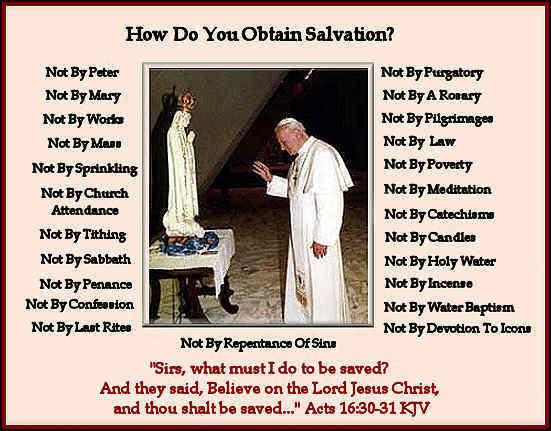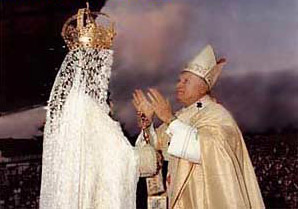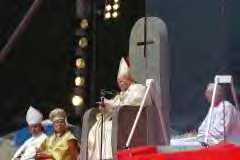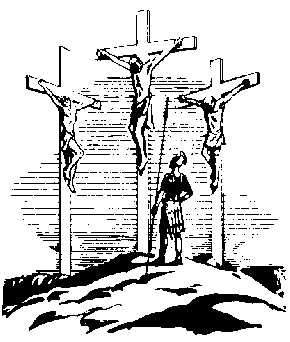Roman Catholicism
Christian or Pagan?
The Roman Catholic Church, headquartered in Rome, Italy, has its own powerful City-State, the Vatican, and claims over 968 million members worldwide and 60 million in the U.S. and Canada (as of 1996). (Catholic membership figures are considerably misleading, though, in that they count as members every person who has been baptized Catholic, including millions of people who were baptized as infants but who are not practicing Catholics.) The Roman Catholic Church, in its pagan form, unofficially came into being in 312 A.D., at the time of the so-called "miraculous conversion" to Christianity of the Roman Emperor Constantine. Although Christianity was not made the official religion of the Roman Empire until the edicts of Theodosius I in 380 and 381 A.D., Constantine, from 312 A.D. until his death in 337, was engaged in the process of simultaneously building pagan temples and Christian churches, and was slowly turning over the reigns of his pagan priesthood to the Bishop of Rome. However, the family of Constantine did not give up the last vestige of his priesthood until after the disintegration of the Roman Empire -- that being the title the emperors bore as heads of the pagan priesthood -- Pontifex Maximus -- a title which the popes would inherit. (The popes also inherited Constantine's titles as the self-appointed civil head of the church -- Vicar of Christ and Bishop of Bishops.)
Prior to the time of Constantine's "conversion," Christians were persecuted not
so much for their profession of faith in Christ, but because they would not
include pagan deities in their faith as well. Then, with Constantine's emphasis
on making his new-found Christianity palatable to the heathen in the Empire, the
"Christianization" of these pagan deities was facilitated. For example, pagan
rituals and idols gradually took on Christian meanings and names and were
incorporated into "Christian" worship (e.g., "saints" replaced the cult of pagan
gods in both worship and as patrons of cities; mother/son statues were renamed
Mary and Jesus; etc.), and pagan holidays were reclassified as Christian holy
days (e.g., the Roman Lupercalia and the feast of purification of Isis became
the Feast of the Nativity; the Saturnalia celebrations were replaced by
Christmas
celebrations; an ancient festival of the dead was replaced by All Souls Day,
rededicated to Christian heroes [now Halloween];
etc.). A transition had occurred -- instead of being persecuted for failure to
worship pagan deities, Christians who did not agree with the particular
orthodoxy backed by the Emperor were now persecuted in the name of Christ!
"Christianized" Rome had become the legitimate successor of pagan Rome! This is
the sad origin of the Roman Catholic Church.

Below are the highlights of what Catholics believe concerning their source of
authority; God, Christ, and Mary; salvation and the sacraments; and heaven and
hell. So much more could be said concerning not only the items listed below, but
also concerning other areas of Catholic teaching (such as the claims of the
Roman priesthood and its supposed origin in the Apostles; the nature of the
pope's alleged infallibility and the supposed origin of his office in the
Apostle Peter; the nature of the Confessional; the doctrine of
penance/indulgences; practices concerning rituals, ceremonies, and relics; the
doctrine of Celibacy; policies on marriage and divorce; the role of the
parochial school; etc.). Excellent reference
sources for a thorough treatment of Catholicismís origins, beliefs, and
practices would be Roman Catholicism (466 pgs.) and A Woman Rides the
Beast (544 pgs.).
1. Source of Authority. With respect to the Bible, Catholics
accept the apocryphal books in addition to the 66 books of the Protestant Bible.
They also accept tradition and the teaching of the Catholic Church as
authoritative and at least equal to that of the Bible (cf. Mk. 7:8,9,13; Matt.
15:3,6,9; Col. 2:8). With respect to papal infallibility, Catholics believe that
ecumenical councils of bishops and the pope are immune from error when speaking
ex cathedra about faith and morals (i.e., "from the chair" -- by
sole virtue of position or the exercise of an office). (And by "infallible,"
Catholics mean much more than merely a simple, de facto absence of
error -- it is positive perfection, ruling out the possibility
of error. In actuality, Roman Catholicism places
itself above Scripture; i.e., it teaches that the Roman Catholic Church produced
the Bible and that the pope is Christ's vicar on earth. Catholics also maintain
the belief in sacerdotalism -- that an ordained Catholic priest has the power to
forgive sins (cf. 1 Tim. 2:5). This of course is a false teaching
because no one can forgive sin other then God Himself (Mark 2:7). The Word
of God is the ONLY true source of truth, not church tradition.
2. Jesus Christ. Catholicism teaches that Christ is God, but
they, nevertheless, do not believe that Christ's death paid the full
penalty for sin; i.e., they believe that those who qualify for heaven must still
spend time in purgatory to atone for sin (cf. John. 19: 30; Hebrews 10:11,12).
There is nothing taught in the Bible about purgatory. Catholics diminish
Christ's deity (as do other cults), but in a different manner; instead of
bringing Christ low by denying his deity, Catholics elevate Mary high in an
attempt to make her equal with Christ, this is heresy.
3. Mary. The Catholic Church gives honor and
adoration to Mary that the Scriptures do not; she is readily referred to
as "holy," the "Mother of God," and has been dubbed the "Co-Redemptrix," thereby
making her an object of idolatrous worship (e.g., the rosary has ten prayers to
Mary for each two directed to God). In 1923, Pope Pius XI sanctioned Pope
Benedict XV's (1914-1922) pronouncement that Mary suffered with Christ, and that
with Him, she redeemed the human race. And Pope Pius XII officially designated
Mary the "Queen of Heaven" and "Queen of the World." Catholics claim not only
that Mary was perfectly sinless from conception, even as Jesus was (doctrine of
Immaculate Conception, proclaimed by Pope Pius IX in 1854), but that the reason
she never sinned at any time during her life was because she was unable
to sin (cf. Luke 1:46,47; Rom. 3:10,23; 5:12; Heb. 4:15; 1 John 1:8,10). Catholics
also believe that Mary was a perpetual virgin (cf. Ps. 69:8; Matt. 1:24,25;
13:54-56; Mk. 6:3; John 7:5), and that she was assumed, body and soul, into
heaven (doctrine of Assumption of Mary, declared ex cathedra by
Pope Pius XII in November of 1950 -- that Mary was raised from the dead on the
third day after her death, and anyone who refuses to believe this has committed
a mortal sin). The consequence of all this veneration of Mary, in effect,
establishes her authority above Christ's -- Rome says, "He came to us
through Mary and we must go to Him through her." All this is so
obviously idolatrous, one wonders why Catholics take offense when their
religious affections are called cultic. Exodus 20:4,5 (the Ten
Commandments) strictly forbids bowing down to any likeness of anything in heaven
(this includes Mary). It's the 2nd command, read it for yourself!
It's the same Scripture found in the Catholic Bible, so why do they disobey God?
4. Salvation. Catholics teach that a person is saved through the Roman Catholic Church and its
sacraments, especially through baptism; they do not believe that salvation can
be obtained by grace through faith in Christ alone, but that
baptism is essential to salvation. Catholics believe that no one outside the Catholic
Church can be saved (Unum Sanctum) (cf. John 5:24; Ephesians 2:
8,9; Galatians 2:21; Romans 3:22,23). They also believe that one's own
suffering can expiate the sin's of himself and of others, so that what
Christ's suffering was not able to achieve, one can achieve by his own works and
the works of others (Vatican II). These are all lies of the Catholic
church! The thief on the cross was never baptized. The Apostle Paul
said Jesus had not sent him to baptize, but to preach the gospel (1st
Corinthians 1:17). Jesus didn't baptize (John 4:2).
5. Sacraments.
Catholics have seven sacraments: baptism, confirmation,
Eucharist (mass), penance/reconciliation (indulgences), extreme unction (last
rights), marriage, and orders (ordination). Although not even formally decreed
until the Council of Florence in 1439, the Council of Trent later declared all
to be anathema whom do not hold Rome's position that it was Christ Himself who
instituted these seven sacraments! (The idea behind the sacraments is that the
shedding of Christ's Blood in His death upon the cross is of no value unless it
is somehow dispensed and applied "sacramentally" by the Catholic priesthood.)
Although Catholics believe that the first five sacraments are indispensable for
salvation (because without any one of them, a mortal sin has been committed),
baptism is considered the most important. Catholics believe that a person enters
into the spiritual life of the Church through baptism; i.e., baptismal
regeneration -- that a person can be saved through baptism (actually, 'on the
road to salvation,' because Catholics never know exactly when they are saved).
They practice infant baptism because they believe baptism erases original sin
(cf. John 3:18). Titus 3:5 makes clear that we cannot be saved by works,
"Not by works of righteousness..." There are NO sacraments taught in the
Bible. Nothing is essential for our salvation other than simple child-like
faith in the Lord Jesus Christ as personal Saviour to forgive our sins.
6. The Mass. Unknown in the early church, the mass did not
become an official doctrine until pronounced by the Lateran Council of 1215
under the direction of Pope Innocent III, and reaffirmed by the Council of
Trent. The Church of Rome holds that the mass is a continuation of the sacrifice
that Christ made on Calvary -- in effect a re-crucifixion of Christ over and
over again in an unbloody manner (cf. Hebrews 9:22; 1 John 1:7). They believe that
by this means Christ offers Himself again and again as a sacrifice for sin (cf.
Hebrews 7:27; 9:12,25,26; 10:10,12,14,18), and that this sacrifice is just as
efficacious to take away sin as was the true sacrifice on Calvary. Catholics
thus teach the doctrine of transubstantiation (meaning a change of
substance) -- that the bread and wine (at communion) actually become
(by the power of the priest!) the body and blood of Christ, which is then
worshiped as God Himself! Indeed, the sacrifice of the mass is the
central point of Catholic worship, as evidenced by the fact that those
abstaining from attending mass are considered to have committed a mortal sin.
Of course, holy communion is not taught in the Bible. The Bible teaches
the "Lord's supper" which was simply an ordinance that Christ initiated for
believers to do in remembrance of Him, no more. There is nothing magical
about the Lord's supper. Nothing changes into anything. It is simply
a time to remember Christ in an official church manner, Jesus is NOT dying
again. The book of Hebrews tells us repeatedly that Jesus died "once" for
all.
7. Purgatory. Of pagan origin, the Roman Church
proclaimed purgatory as an article of faith in 1439 at the Council of
Florence, and it was confirmed by Trent in 1548. The Catholic Church teaches
that even those "who die in the state of grace" (i.e., saved and sins forgiven)
must still spend an indefinite time being purged/purified (i.e., expiated of
sins/cleansed for heaven). Technically, this "purging" can occur in this life
rather than in purgatory itself, but as a practical matter, purgatory is the
best the average Catholic can hope for. Some Catholics will admit that the
doctrine of purgatory is not based on the Bible, but on Catholic tradition
(which, by Catholic standards, is equally authoritative) (cf. John 5:24; Luke
23:43; 1 John 1:7,9; Phil. 1:23). (Others teach that it is based upon the
interpretation of several Scriptural texts -- 1 Corinthians 3:15; 1 Peter 1:7; 3:19;
Matt. 12:31.) They teach that those in purgatory can be helped by the prayers
and good works of those on earth (which would include the "purchase" of masses
and/or other indulgences), but they are not certain how these prayers and works
are applied (cf. 2 Peter 1:9; Hebrews 1:3; John 3:18; 19:30; 2 Corinthians 5:6-8).
8. The Church Councils. There have been three major Roman
Catholic Councils: Council of Trent (1545-1563), Vatican I (1869-1870), and
Vatican II (1962-1965). The last Council, Vatican II, offered no new doctrines
nor repudiated any essential teaching of the Roman Church; it referred to Trent
dozens and dozens of times, quoted Trent's proclamations as authority, and
reaffirmed Trent on every hand. Even the New Catholic Catechism (1992/1994) cites Trent no less than 99 times! There
is not the slightest hint that the proclamations of the Council of Trent have
been abrogated by Rome. At the opening of the Second Vatican council, Pope John
XXIII stated, "I do accept entirely all that has been decided and declared at
the Council of Trent," and all of the Catholic leaders who attended Vatican II
signed a document containing this statement. (The current pope, Pope John Paul
II, has even cited the Council of Trent as authority for his blasphemous
position on Mary.):
Council of Trent -- The Council of Trent was held in an attempt to destroy the progress of the Protestant Reformation; it approved many superstitious and unbiblical beliefs of the Middle Ages (all to be believed under the threat of "anathema"):
(a) Denied every doctrine of the Reformation, from Sola Scriptura to "salvation by grace through faith alone";
(b) Pronounced 125 anathemas (i.e., eternal damnation) upon anyone believing what evangelicals believe and preach today;
(c) Equal value and authority of tradition and Scripture (in actuality, tradition is held above Scripture);
(d) Scriptures for the priesthood only (prohibited to anyone in the laity without written permission from one's superior -- to violate this was [and still is in most "Catholic countries" today] considered a mortal sin);
(e) Seven sacraments;
(f) Communion by eating the bread only (not drinking the wine);
(g) Purgatory;
(h) Indulgences;
(i) The Mass as a propitiatory offering.
Vatican I
(a) Defined the infallibility of the pope;
(b) Confirmed Unum Sanctum (no salvation outside of the Catholic Church).
Vatican II -- made no new doctrines, nor did it change or repudiate any old ones; Trent and Vatican I stand as is (i.e., Vatican II verified and validated all the anathemas of Trent). Vatican II reaffirmed such Roman heresies as papal supremacy; the Roman priesthood; the mass as an unbloody sacrifice of Christ; a polluted sacramental gospel; Catholic tradition on equal par with Scripture; Mary as the Queen of Heaven and co-Redemptrix with Christ; auricular confession; Mariolatry; pilgrimages to "holy shrines"; purgatory; prayers to and for the dead; etc. (Although the restriction against laity reading the Scriptures has been removed, it is still a mortal sin for a Roman Catholic anywhere to read any Protestant version of the Bible. That the real attitude of the Vatican toward the Bible has not changed is shown by the fact that in 1957 the depot of the British and Foreign Bible Society in Madrid, Spain was closed and its stock of Bibles confiscated and burned.)
(a) Reaffirmed the infallibility of the pope (and even when he does not speak ex-cathedra, all Catholics must still give complete submission of mind and will to what he says);
(b) Divided Catholic doctrine into that which is essential core of theology, and must be received by faith, and that which is still an undefined body of theology which Catholics may question and debate without repudiating their essential Catholicism;
(c) Established 20 complex rules concerning when and how any indulgence may be obtained, and condemned "with anathema those who say that indulgences are useless or that the Church does not have the power to grant them ... [for] the task of winning salvation."
A Sampling of the Anathemas (curses) of Trent:
If any one shall deny that the body and blood together with the soul and divinity of our Lord Jesus Christ, and therefore entire Christ, are truly, really, and substantially contained in the sacrament of the most holy Eucharist; and shall say that He is only in it as a sign, or in a figure, or virtually -- let him be accursed (Canon 1).
If any one shall say that the substance of the bread and wine remains in the sacrament of the most holy Eucharist, together with the body and blood of our Lord Jesus Christ, and shall deny that wonderful and singular conversion of the whole substance of the bread into the body, and of the whole substance of the wine into the blood, the outward forms of the bread and wine still remaining, which conversion the Catholic Church most aptly calls transubstantiation -- let him be accursed (Canon 2).
If any man shall say that Christ, the only begotten Son of God, is not to be adored in the holy sacrament of the Eucharist, even with the open worship of latria, and therefore not to be venerated with any peculiar festal celebrity, nor to be solemnly carried about in processions according to the praiseworthy, and universal rites and customs of the holy Church, and that he is not to be publicly set before the people to be adored, and that his adorers are idolaters -- let him be accursed (Canon 6).
If anyone shall say that the ungodly man is justified by faith only so as to understand that nothing else is required that may cooperate to obtain the grace of justification, and that it is in no wise necessary for him to be prepared and disposed by the motion of his own will ... let him be accursed (Canon 9).
If anyone shall say that justifying faith is nothing else than confidence in the divine mercy pardoning sins for Christ's sake, or that it is that confidence alone by which we are justified ... let him be accursed (Canon 12).
These traditions which began at the Council of Trent are all heresies, NOT based upon the Word of God! Catholicism is a pagan religion, far far from the truth of God's Word. They have churchianity without Christianity!



